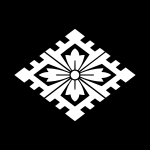Ōuchi clan
| Ōuchi clan 大内氏 | |
|---|---|
 The emblem (mon) of the Ōuchi clan | |
| Home province | Suō |
| Parent house |
Paekche Royal House (according to tradition) Tatara clan (多々良氏) |
| Titles | Various |
| Founder | Ōuchi Morifusa (大内盛房) |
| Final ruler | Ōuchi Yoshinaga |
| Founding year | 12th century |
| Dissolution | 1557 |
| Ruled until | 1557, Ōuchi Yoshinaga commits seppuku |
Ōuchi clan (大内氏 Ōuchi-shi) was one of the most powerful and important families in Japan during the reign of the Ashikaga shogunate in the 12th to 14th centuries. Their domains, ruled from the castle town of Yamaguchi, comprised six provinces at their height, and the Ōuchi played a major role in supporting the Ashikaga in the Nanboku-cho Wars against the Imperial Court. The Ōuchi remained powerful up until the 1560s, when they became eclipsed by their vassals, the Mōri clan.
History
Local legend in modern Yamaguchi City has it that the Ōuchi clan were of continental origins, specifically descended from a prince of Baekche, and this is supported by the Ōuchi-shi Jitsruroku (大内氏実録), a work of the historian Kondō Kiyoshi (近藤清石, 1833–1916), but is disputed.[1]
Based in Suō Province, towards the western end of Honshū, the Ōuchi were among the primary families to be involved in foreign trade and relations, particularly with China. Following the Ōnin War (1467–1477), a strong rivalry developed between the Ōuchi and the Hosokawa family, who were now in power. The two clashed at Ningbo in 1523, and as a result the Chinese closed Ningbo to Japanese traders. After the incident, the Ōuchi ships were only allowed to trade in China in 1540 and 1549. The Ōuchi also housed the Portuguese Jesuit missionary Francis Xavier for a time in 1551.
As a result of their wealth and trading contacts, the Ōuchi gained renown in the worlds of art and culture as well. They possessed countless items of cultural and artistic significance and beauty, from Japan and China, as well as from further abroad. Particularly famous was the invitation by Ōuchi Masahiro of the famous painter Sesshū to Yamaguchi in 1486.
The prosperity of the Ōuchi was such that they attempted to bring the Emperor Go-Nara to move his capital from the war-torn Kyoto to their home city Yamaguchi in 1551, but the backlash against this plan by the Ōuchi's military establishment caused a rebellion which forced the daimyō Ōuchi Yoshitaka to commit suicide.[2] The Ōuchi line proper ended here—for the next (and last) clan head Ōuchi Yoshinaga, installed by the leader of the rebellion Sue Harukata, was actually the younger brother of the Ōuchi rival Ōtomo Sōrin. Yoshinaga committed suicide two years after the Battle of Miyajima of 1555 in which Sue Harukata was defeated by Mōri Motonari, another former vassal of Yoshitaka.
Clan heads
- Ōuchi Morifusa (大内盛房)
- Ōuchi Hiromori (大内弘盛)
- Ōuchi Mitsumori (大内満盛)
- Ōuchi Hironari (大内弘成, ? –1244)
- Ōuchi Hirosada (大内弘貞, ? –1286)
- Ōuchi Hiroie (大内弘家, 1274?–1300)
- Ōuchi Shigehiro (大内重弘, ? –1320)
- Ōuchi Hiroyuki (大内弘幸, ? –1352)
- Ōuchi Hiroyo (大内弘世, 1325–1380)
- Ōuchi Yoshihiro (大内義弘, 1356–1400) – Led a revolt against Shogun Ashikaga Yoshimitsu.
- Ōuchi Moriharu (大内盛見, 1377–1431)
- Ōuchi Mochiyo (大内持世, 1394–1441)
- Ōuchi Norihiro (大内教弘, 1420–1465)
- Ōuchi Masahiro (大内政弘, 1446–1495) – one of Yamana Sōzen's chief generals in the Ōnin War.
- Ōuchi Yoshioki (大内義興, 1477–1529) – Restored the shogun Ashikaga Yoshitane to power after a fifteen-year absence in 1508.
- Ōuchi Yoshitaka (大内義隆, 1507–1551) – The lord who oversaw the height of Ōuchi power and saw it end abruptly.
- Ōuchi Yoshinaga (大内義長, 1532?–1557) – The last Ōuchi lord, he was the son of Sengoku daimyō, Ōtomo Yoshiaki, and thus not of Ōuchi blood.
Notes
- ↑ Zhang 2016, p. 74.
- ↑ Conlan, Thomas (2015). "The Failed Attempt to Move the Emperor to Yamaguchi and the Fall of the Ōuchi". Japanese Studies. 35 (2): 194. doi:10.1080/10371397.2015.1077679. Retrieved 6 March 2016.
References
- Sansom, George (1961). A History of Japan: 1334–1615. Stanford: Stanford University Press.
- Sansom, George Bailey (1962). Japan: A Short Cultural History. New York: Appleton-Century-Crofts, Inc.
- Turnbull, Stephen (1998). The Samurai Sourcebook. London: Cassell & Co.
- Zhang, Yuling (March 2016). "The Expansion and Specialization of the Matsuri in Regional Cities: Focusing on the Idea of Ohuchi Clan Origins and Its Appropriation in the Yamaguchi Tanabata Lantern Festival" (PDF). Kokusai Bunka Gakubu Kiyō (in Japanese). Yamaguchi Prefectural University. 22 (1): 71–86. Retrieved 2018-01-27.